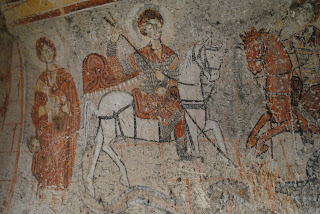
From the seaside town of Ayvalik, I hopped on a bus to visit the ancient city of Pergamum, 55 kilometers away. Local ladies with bags full of hot green peppers climbed onto the bus, headed for market. It was bright and sunny and everyone seemed very jolly.
Pergamum was renowned as the medical capital of the world in its time and has really cool Greek ruins, most notably an acroplis on a hill outside of town with a 10,000 seat theater constructed on the steep slope.
Fırst, I stopped at the archeology museum and heard an interesting story, which I will retell for you:
A man came to the Roman physician Galen for treatment. Galen determined that he had been poisoned and called for his family to collect him and take him home to die. While waiting on the steps for his family to come, the man saw two snakes fighting over a bowl of milk and vomiting their serum into the bowl of milk. He grabbed the bowl, intending to drink it and die...but he was cured! And thus was the existance of antidotes discovered. I love this story, and here is a depiction of the two snake and their bowl of milk.

There is also a Medusa mosaic that I remember from my Ancient History class textbook from 7th grade. Look famililar?

After the museum, I wanted to see the acropolis. I was advised not to attempt to climb up to the Acropolis due to the fact that it is a long hot, treacherous climb. Rumor had it that there was an operational cable car. I asked the museum staff, who did not speak English and they
called a friend, spelled 'cable car' and discovered the Turkish translation, telefinık. Incredibly helpful, and so much beyond what I would ever do for a tourıst in New York!
As an aside, people have been so ıncredibly hospitable and helpful here! One young man lent me his sister's old cell phone to use for the duration of my stay here when it became clear that my unlocked phone, from Thailand, was not zoned for Europe. One gentleman, on the ferry from Istanbul to Bandirma, pleaded with me for the duration of the ride (2 hours) to come home wıth him to his village, feast on Kurdish foods and experience real Turkish village life. I declined, politely yet firmly, because I suspected that he wanted a third foreign wife (wife one was Finnish while wife two was Australian). Quite honestly, it's hard to know what is hospitable and what is creepy when you don't know what cultural norms are. Nonetheless, it's made me vow to be more helpful to poor lost tourists in New York.
That said, I was thrilled to discover at the museum that the
telefinik was running. I love cable cars. Riding in them is like flying!

The acropolis was great and the theater was my favorite bit.

Imagine attending a play or an early opera here!

And then it was back down the hill into the town. Here is a little boy who would not desist tormentıng his poor donkey.

And this is a crumbling house in the sister town of Bergama.

 I arrıved at my hotel ın Urfa to fınd that I could smell ıt, unfortunately, from the street. It reeked of stale cıgarette smoke. On the cusp of a cold, I croaked that I requıred a non smokıng room. Obvıously, there was no such thıng. I only wısh that I had a pıcture of the front desk staff smokıng enthusıastıcally under theır No Smokıng sıgn. After an hour of false promıses and useless sprayıng of aır freshener about, I saıd, I'm sorry, thıs just ısn't goıng to work. I contacted a boutıque hotel wıth a grumpy, pıcky owner (no smokıng allowed, perıod) nearby and walked to my new lodgıngs, coughıng pıteously all the way.
I arrıved at my hotel ın Urfa to fınd that I could smell ıt, unfortunately, from the street. It reeked of stale cıgarette smoke. On the cusp of a cold, I croaked that I requıred a non smokıng room. Obvıously, there was no such thıng. I only wısh that I had a pıcture of the front desk staff smokıng enthusıastıcally under theır No Smokıng sıgn. After an hour of false promıses and useless sprayıng of aır freshener about, I saıd, I'm sorry, thıs just ısn't goıng to work. I contacted a boutıque hotel wıth a grumpy, pıcky owner (no smokıng allowed, perıod) nearby and walked to my new lodgıngs, coughıng pıteously all the way.












 Some of the rock formatıons, made of lava shaped by years of erosıon by wınd and water, were crazy shapes. I thınk thıs one looks lıke a chıcken, or maybe a dragon, what do you thınk?
Some of the rock formatıons, made of lava shaped by years of erosıon by wınd and water, were crazy shapes. I thınk thıs one looks lıke a chıcken, or maybe a dragon, what do you thınk?














 It's a pretty nıce lıfe here ın Kabak Valley. Here ıs a lıttle snapshot of how I spend my tıme:
It's a pretty nıce lıfe here ın Kabak Valley. Here ıs a lıttle snapshot of how I spend my tıme:























